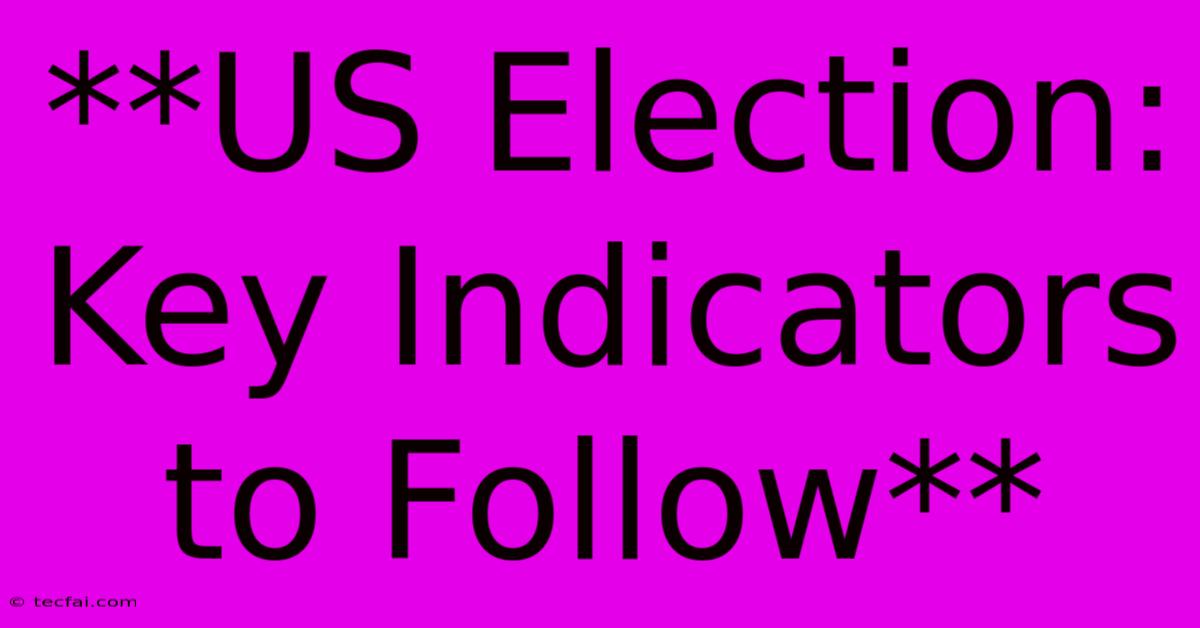**US Election: Key Indicators To Follow**

Discover more detailed and exciting information on our website. Click the link below to start your adventure: Visit Best Website tecfai.com. Don't miss out!
Table of Contents
US Election: Key Indicators to Follow
The US election cycle is a complex and dynamic process, with numerous factors influencing the outcome. While it's impossible to predict the future with certainty, following specific key indicators can provide valuable insights into the potential trajectory of the race.
This article will delve into some of the most important indicators to watch as the election approaches, helping you navigate the information landscape and understand the dynamics at play.
1. Polls and Surveys: Gauging Public Sentiment
Polls and surveys are often the first thing people turn to when seeking insights into election trends. These tools measure public opinion and can provide a snapshot of the current race. However, it's crucial to approach them with caution, considering the following:
- Methodology: Pay attention to the poll's methodology, including sample size, margin of error, and the way questions are framed.
- Sampling Bias: Be aware of potential sampling bias, which can occur if the poll doesn't accurately reflect the demographics of the electorate.
- Time of Measurement: Polls conducted closer to the election date tend to be more accurate, as they capture the latest shifts in public opinion.
2. Early Voting and Voter Registration Data: Assessing Turnout
Early voting and voter registration data can provide valuable insights into voter turnout and enthusiasm. Here's what to watch:
- Early Voting Trends: High early voting numbers can indicate a strong level of voter engagement, while lower numbers could suggest less enthusiasm for the race.
- Voter Registration Data: Changes in voter registration patterns, especially among specific demographic groups, can signal potential shifts in the electorate.
3. Campaign Spending and Fundraising: Measuring Resource Allocation
Campaign spending and fundraising are crucial components of any election.
- Fundraising: Candidates who raise more money can afford to run more robust campaigns, reaching a wider audience and deploying more resources.
- Spending: Analyze where campaigns are allocating their resources. High spending in specific states or regions can indicate where the race is tightest.
4. Media Coverage: Shaping Public Perception
Media coverage plays a significant role in shaping public perception of candidates and issues.
- Bias and Framing: Be aware of potential biases in media coverage, as outlets may favor certain candidates or narratives.
- Focus on Key Issues: Pay attention to the issues receiving the most media attention, as they often reflect the concerns of the electorate.
5. Economic Indicators: Gauging the Health of the Nation
Economic indicators, such as GDP growth, unemployment rates, and inflation, can influence voter sentiment and impact the election.
- Economic Growth: A strong economy tends to benefit the incumbent party, while a weak economy can favor the challenger.
- Consumer Confidence: High consumer confidence signals a positive economic outlook, while low confidence can indicate economic uncertainty.
6. Social Media Sentiment: Tracking Online Conversations
Social media sentiment analysis can provide valuable insights into public opinion and the way voters are engaging with the election.
- Trending Topics: Identify trending topics and hashtags related to the election, which can highlight key issues and voter concerns.
- Candidate Perception: Analyze the online sentiment surrounding candidates, gauging their popularity and public image.
Conclusion
Understanding and analyzing these key indicators can help you navigate the complexities of the US election cycle. Remember that no single indicator is foolproof, and the election outcome will be influenced by a combination of factors. However, by paying close attention to these metrics, you can gain valuable insights into the dynamics of the race and make more informed decisions about the upcoming election.

Thank you for visiting our website wich cover about **US Election: Key Indicators To Follow**. We hope the information provided has been useful to you. Feel free to contact us if you have any questions or need further assistance. See you next time and dont miss to bookmark.
Featured Posts
-
Quincy Jones Newsom Offers Condolences
Nov 05, 2024
-
10 Weeks On The Camino Pamplona Logrono Stages
Nov 05, 2024
-
Buccaneers Vs Opponent Live Updates Mnf
Nov 05, 2024
-
2024 C And I Symposium Day Two In Review
Nov 05, 2024
-
Roy Keane To Perform At The Marquee
Nov 05, 2024
